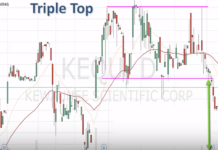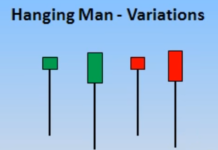This article focuses on two common trend reversal formations, Double Top and Double Bottom. We’ll look at when these patterns occur, what they look like, and how to trade them, Also, you’ll find out how to determine stop loss amount and price momentum after entry. Double Top and Double Bottom are reversal patterns, i.e. they signal that the previous trend has come to an end and the opposite trend is emerging. If there is an uptrend, the pattern consists of highs. If there is a downtrend, the pattern consists of lows.
Before reading the article and writing your questions in the comments section, I recommend to watch this video. It’s not long but covers the biggest part of questions on the topic.
Table of Contents
DOUBLE TOP
Let’s start with the Double Top pattern. The main condition for this pattern to occur is a strong uptrend that signifies that buyers are dominating the market.

On the chart above, an uptrend makes a new high. Then the price pulls back and makes a local low.
That way, price actions tells us that there are buyers who expect the uptrend to continue, preventing the price from falling further.
The buyers take back control of the market and the price starts to climb up. When the price is approaching the level of the first high, buyers are confronted with sellers.
As a result, the price makes a second high. In theory, the two highs are supposed to be on the same level. However, this is not always the case in real life. It’s not uncommon that the second top forms slightly above or below the first one.
The buying pressure is about to end. Sellers start to push the price down to the old low that occurred after the first high.
Sellers beat buyers again. As a result, a bearish breakout occurs, confirming trend reversal.
DOUBLE BOTTOM
The Double Bottom pattern is the opposite of the Double Top pattern. Seeing a Double Bottom pattern means that a downtrend has lost its steam and the price is about to change its direction.

After a lengthy downward movement, the price makes a new low. Then it starts to go up and makes a local high.
This local high shows that sellers are not ready to give up yet. As a result, buyers surrender and the price continues to fall until it makes another low.
As the price approaches the level of the first low, buyers decide to stand their ground and strike back.
The price starts to rise and approaches the old high. A bullish breakout occurs, which confirms the emergence of an uptrend.
To determine how far the price will go after it has left the Double Top pattern, you need to measure the distance between the two highs and the local low.

In most cases, this will be the distance the price will cover on its way up. Traders use this value to set a take profit.
As for the Double Bottom pattern, the price momentum is assessed just the same. You need to measure the distance between the lows and the local high.
ENTRY POINTS
Now let’s see when you should open a trade and where you should place your stop loss.
There are several ways to trade the Double Top and Double Bottom patterns.

As an example, let’s consider the entry opportunities for the Double Top pattern:
According to Strategy No. 1, you need to open a position after the price has hit two highs and trade around that level. This method comes with substantial risk as a trader opens a short trade without waiting for the pattern to fully develop. At the same time, this method can earn you a sizeable profit. If you choose this strategy, you should place your stop-loss slightly above the highest high.
If you’ve opted for Strategy No.2, you need to wait for the pattern to fully form and open a trade after the candle, which broke out of the local low, has closed below the support level. Although in this case the entry point is much lower than in Strategy No.1, you need to place a stop loss above the highest high.
Strategy No.3 tells you to enter a trade after the price has tested the resistance level — which used to be the support level before the price broke the local high. Place your stop-loss slightly above the resistance line.
For the Double Bottom pattern, the same entry strategies apply, the only difference being that you open a trade in the opposite direction.
TAKEAWAY
In this article, we’ve covered what the Double Top and Double Bottom patterns look like on the chart and how to determine a price momentum after reversal confirmation. Plus, we’ve outlined the three methods to effectively trade these patterns.






Awesome explanations!! Really helpful and easy to understand. THUMBS UP!!
thank you . this is very difficult to apply in crypto market and bit coins in general
Think i found my new site, very simple explanations from the ones i have seen, which is great as i see a lot of channels over explaining it or going into to much depth, simple and clean is always best, thanks
Is this analysis also correct with the 5min charts? I mean, if we got the same waves in a 5min chart, it also means the same thing or is less accurate? And thanks for your tutorial, you make this look really simple and clear.
Always though shoulders were supposed to be at the same level… thanks for
Always though shoulders were supposed to be at the same level… thanks for clarifying
Can this be applied to any stock?
I have a question. Could we trade false double tops/bottoms like false breakout?
Awesome content… thanks